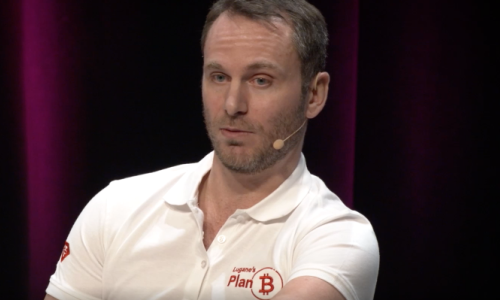Pushing The Stablecoin to The End of Its Tether
Chief technology officer Paolo Ardoino told finews.asia why Tether’s stablecoin can hold up to attacks from hedge funds while mayor Michele Foletti explained why Lugano's crypto partner is still good for the city.
The knock-on effect for Tether after the TerraLuna crash was immediate and unprecedented: Big hedge funds announced that they would test Tether’s US dollar peg by shorting it and have been doing so ever since.
Within 48 hours of TerraLuna's collapse Tether's stablecoin was forced to make $7 billion worth of redemptions, «that was 10 percent of all of our assets,» chief technology officer Paolo Ardoino, said.
Blowing a Hole
In recent financial history «there is only one case of an institution attempting to redeem 10 percent of its assets,» he added, referring to when Washington Mutual filed for bankruptcy in 2008 before being taken over by J.P. Morgan. «And they had 10 days and failed.»
Of those outflows, 30 percent went to another stablecoin – USDC – while the rest has left the crypto universe entirely, blowing a hole in Tether’s market capitalization, which now stands at $63 billion, down from $83 billion since the beginning of May.
Perfect Storm
Besides the TerraLuna crash, Ardoino sees over-leveraging by lenders, and an increase in interest rates on US dollar assets as having caused a perfect storm, resulting in billions of dollars being drained out of the crypto industry.
Higher interest rates meant people were keeping money in the bank as they couldn’t get any yield on the stablecoin, while «over-leveraging has been burdening the market for too long and needs to stop» Ardoino said.

Paolo Ardoino, CFO at Tether (Image: Lugano Plan B)
At Tether, «we take risk management seriously. By contrast, many companies in the ecosystem have been providing loans to traders without any collateral, creating enormous leverage in the system which pushed the price of Bitcoin to $18,000,» he said.
A silver lining of the crash is that it has allowed Tether to differentiate itself from other stablecoins: «While Terra was backed by its own token Luna- essentially, by goodwill – Tether is based on a liquid portfolio of hard assets,» Ardoino said.
Pocketing the Difference
Yet hedge funds are still shorting Tether, pushing its price down on exchanges by buying back coins at a lower price than they sold them for. Market makers, taking advantage of the price mismatch, are buying these «cheaper» tethers and redeeming them with Tether for $1 per coin, and pocketing the difference.
For Ardoino, the situation is clear, regardless of the market dynamics or whether Tether is under attack by arbitrageurs «as a stablecoin, our only job is to give money back to people when they ask for it,» he said.
Doubt Among Critics
To be sure, the company’s ability to do so depends on the quality of Tether’s reserves, something which has raised doubt among its critics, with its commercial paper having drawn the most scrutiny in the past.
Today the majority of Tether’s assets are in US Treasuries, Ardoino said. Tether has reduced the amount held in commercial paper to $8.4 billion from $45 billion 10 months ago, and will further reduce it to zero by the second half of this year.
Revealing Its Reserves
According to a blog post by Tether, the scepticism is driven by hedge funds dispersing misinformation aiming to move markets in the direction that they need «in order to make a spread.» A big part of Ardoino’s time is spent explaining the quality of the stablecoin's reserves and educating the community, who don’t all come from the financial sector.
Michele Foletti, Mayor of Lugano (Image: City of Lugano)
At least Lugano’s mayor Michele Foletti (pictured above) doesn’t doubt how Tether is backed.
He has welcomed the crypto company as a partner of the City’s «Plan B,» an initiative, which builds on the city's institutional blockchain 3Achain, and is available to local businesses, as well as encouraging the use of certain cryptocurrencies in the city.
High Level of Understanding
On meeting representatives from the city’s mayor's office in October last year, Ardoino soon realized that they were well advanced in their digitization efforts and had a high level of understanding of the distributed ledger, which they used for legal purposes, such as for the notarization of documents.
A part from building its own blockchain, the city had introduced its own digital currency «LVGA,» allowing shoppers to pay and gain points with the «MyLugano» cashback app, which 10 percent of its 70,000 inhabitants has signed up for since its launch last year.
«Lugano was further ahead than any other city or country in the world with what they had created,» Ardoino said.
New Crypto Hub
The city, which is aiming to fully digitize its citizen services by 2028 and establish itself as a crypto and blockchain hub, has faced its fair share of criticism for agreeing to partner with Tether as «some opponents criticized the crypto industry’s use of energy, as well as expressing concerns about cryptocurrencies being used for money laundering and for criminal activities,» Foletti said.
Surprisingly those voices didn’t resound after TerraLuna collapsed, which is because «people have come to understand and appreciate what the city is doing,» according to Foletti.
Track and Block Assets
And when it comes to concerns around security, «there has been no correlation between the number of cyber attacks and the announcement of plan B,» the mayor said, adding that risks are often «a question of individuals and businesses not seeking the necessary protection.»
Besides, «the majority of money that gets lost does so on the banking side, Ardoino said. The problem is that banks, which don’t have a public ledger, are not transparent, making it difficult to track funds once they disappear, he added.
Tether, on the other hand, has the ability to freeze, track and block assets on the blockchain and has helped law enforcers, private companies and private citizens «get back more than $180 million worth of our stablecoin in the past 24 months,» Ardoino said.
Servicing the Unbanked
While its competitor USDC caters to the traditional banking system – aiming to replace the dollar – Tether sees itself as «complementary » to banks, Ardoino said.
«Tether created the stablecoin with the idea in mind that banks already have the best (form of the) dollar and Wall Street has the best banking system to move dollars,» he said.
It’s the 2 billion people that don't have access to a bank account and 4 billion that are exposed to weak and volatile national currencies, which Tether says it wants to service.
Outdated Technology
Comparing Tether to USDC, Ardoino says «both of us are $1 on a blockchain, but USDC is focused on giving services to banks, whereas we focus on offering services to people in Argentina, Brazil, Venezuela, El Salvador, India, Turkey and almost everywhere in Africa.»
«For me it doesn't make sense to compete with banks. We want to serve people that banks have difficulties attending to,» said Ardoino who attributes this to their «high costs related to their outdated technology.»
In this regard, perhaps Lugano's 3Achain is a good place for some Swiss banks to get started.




























